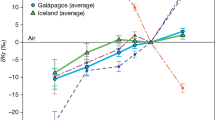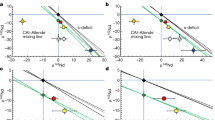Abstract
In the atmospheres of Earth and Mars, xenon is strongly depleted relative to argon, when compared to the abundances in chondritic meteorites1,2. The origin of this depletion is poorly understood3,4,5,6,7,8,9,10,11,12,13. Here we show that more than one weight per cent of argon may be dissolved in MgSiO3 perovskite, the most abundant phase of Earth’s lower mantle, whereas the xenon solubility in MgSiO3 perovskite is orders of magnitude lower. We therefore suggest that crystallization of perovskite from a magma ocean in the very early stages of Earth’s history concentrated argon in the lower mantle. After most of the primordial atmosphere had been lost, degassing of the lower mantle replenished argon and krypton, but not xenon, in the atmosphere. Our model implies that the depletion of xenon relative to argon indicates that perovskite crystallized from a magma ocean in the early history of Earth and perhaps also Mars.
This is a preview of subscription content, access via your institution
Access options
Subscribe to this journal
Receive 51 print issues and online access
$199.00 per year
only $3.90 per issue
Buy this article
- Purchase on Springer Link
- Instant access to full article PDF
Prices may be subject to local taxes which are calculated during checkout



Similar content being viewed by others
References
Anders, E. & Owen, T. Mars and Earth—origin and abundance of volatiles. Science 198, 453–465 (1977)
Pepin, R. O. & Porcelli, D. Origin of noble gases in the terrestrial planets. Rev. Mineral. Geochem. 47, 191–246 (2002)
Matsuda, J. & Matsubara, K. Noble gases in silica and their implication for the terrestrial missing Xe. Geophys. Res. Lett. 16, 81–84 (1989)
Sanloup, C. et al. Retention of xenon in quartz and Earth’s missing xenon. Science 310, 1174–1177 (2005)
Sill, G. T. & Wilkening, L. L. Ice clathrate as a possible source of atmospheres of terrestrial planets. Icarus 33, 13–22 (1978)
Wacker, J. F. & Anders, E. Trapping of xenon in ice—implications for the origin of the Earth’s noble gases. Geochim. Cosmochim. Acta 48, 2373–2380 (1984)
Jephcoat, A. P. Rare-gas solids in the Earth’s deep interior. Nature 393, 355–358 (1998)
Lee, K. K. M. & Steinle-Neumann, G. High-pressure alloying of iron and xenon: “missing” Xe in the Earth’s core? J. Geophys. Res. 111, B02202 (2006)
Nishio-Hamane, D., Yagi, T., Sata, N., Fujita, T. & Okada, T. No reactions observed in Xe-Fe system even at Earth core pressures. Geophys. Res. Lett. 37, L04302 (2010)
Pepin, R. O. On the origin and early evolution of terrestrial planet atmospheres and meteoritic volatiles. Icarus 92, 2–79 (1991)
Dauphas, M. The dual origin of the terrestrial atmosphere. Icarus 165, 326–339 (2003)
Pujol, M., Marty, B. & Burgess, R. Chondritic-like xenon trapped in Archean rocks: a possible signature of the ancient atmosphere. Earth Planet. Sci. Lett. 308, 298–306 (2011)
Marty, B. The origins and concentrations of water, carbon, nitrogen and noble gases on Earth. Earth Planet. Sci. Lett. 313–314, 56–66 (2012)
Heber, V. S., Brooker, R. A., Kelley, S. P. & Wood, B. J. Crystal-melt partitioning of noble gases (helium, neon, argon, krypton, and xenon) for olivine and clinopyroxene. Geochim. Cosmochim. Acta 71, 1041–1061 (2007)
Kojitani, H., Katsura, T. & Akaogi, M. Aluminum substitution mechanisms in perovskite-type MgSiO3: an investigation by Rietveld analysis. Phys. Chem. Mineral. 34, 257–267 (2007)
Lauterbach, S., McCammon, C. A., van Aken, P., Langenhorst, F. & Seifert, F. Mossbauer and ELNES spectroscopy of (Mg,Fe)(Si,Al)O3 perovskite: a highly oxidised component of the lower mantle. Contrib. Mineral. Petrol. 138, 17–26 (2000)
McCammon, C. A. Perovskite as a possible sink for ferric iron in the lower mantle. Nature 387, 694–696 (1997)
Navrotsky, A. Mantle geochemistry—a lesson from ceramics. Science 284, 1788–1789 (1999)
Navrotsky, A. et al. Aluminum in magnesium silicate perovskite: formation, structure, and energetics of magnesium-rich defect solid solutions. J. Geophys. Res. 108, 2330 (2003)
Stashans, A., Piedra, L. & Briceno, T. Fundamental and excited states of F-type centres in MgSiO3 perovskite. Physica B 405, 4350–4354 (2010)
Stebbins, J. F. et al. Aluminum substitution in stishovite and MgSiO3 perovskite: high-resolution 27Al NMR. Am. Mineral. 91, 337–343 (2006)
Zhang, Y. X. & Xu, Z. J. Atomic radii of noble gas elements in condensed phases. Am. Mineral. 80, 670–675 (1995)
Yang, H. X., Konzett, J. & Prewitt, C. T. Crystal structure of phase X, a high pressure alkali-rich hydrous silicate and its anhydrous equivalent. Am. Mineral. 86, 1483–1488 (2001)
Greenwood, R. C., Franchi, I. A., Jambon, A. & Buchanan, P. C. Widespread magma oceans on asteroidal bodies in the early Solar System. Nature 435, 916–918 (2005)
Porcelli, D., Woolum, D. & Cassen, P. Deep Earth rare gases: initial inventories, capture from the solar nebula, and losses during moon formation. Earth Planet. Sci. Lett. 193, 237–251 (2001)
Morbidelli, A. et al. Source regions and timescales for the delivery of water to the Earth. Meteorit. Planet. Sci. 35, 1309–1320 (2000)
Bolfan-Casanova, N., Keppler, H. & Rubie, D. C. Water partitioning at the 660 km discontinuity and evidence for very low water solubility in magnesium silicate perovskite. Geophys. Res. Lett. 30, 1905 (2003)
Pepin, R. O. Evolution of Earth’s noble gases: consequences of assuming hydrodynamic loss driven by giant impact. Icarus 126, 148–156 (1997)
Brooker, R. A. et al. The ‘zero charge’ partitioning behaviour of noble gases during mantle melting. Nature 423, 738–741 (2003)
Boettcher, S. L., Guo, Q. & Montana, A. A simple device for loading gases in high-pressure experiments. Am. Mineral. 74, 1383–1384 (1989)
Günther, D., Frischknecht, R., Heinrich, C. A. & Kahlert, H. J. Capabilities of an Argon Fluoride 193 nm excimer laser for laser ablation inductively coupled plasma mass spectrometry microanalysis of geological materials. J. Anal. At. Spectrom. 12, 939–944 (1997)
Longerich, H. P., Jackson, S. E. & Gunther, D. Laser ablation inductively coupled plasma mass spectrometric transient signal data acquisition and analyte concentration calculation. J. Anal. At. Spectrom. 11, 899–904 (1996)
Acknowledgements
This work was supported by the German Science Foundation (DFG, SPP 1236). We thank A. Audetat for measurements of Kr and Xe by laser-ablation ICP-MS, N. Miyajima for help with TEM studies of the samples and T. Boffa-Ballaran for preliminary X-ray data of Ar-bearing perovskite.
Author information
Authors and Affiliations
Contributions
S.S.S. carried out all experiments and chemical analyses reported in this paper. H.K. suggested this study. Both authors wrote the manuscript together.
Corresponding author
Ethics declarations
Competing interests
The authors declare no competing financial interests.
Supplementary information
Supplementary Information
This file contains Supplementary Text and Data, Supplementary Figures 1-4, Supplementary Table 1 and additional references. (PDF 368 kb)
Rights and permissions
About this article
Cite this article
Shcheka, S., Keppler, H. The origin of the terrestrial noble-gas signature. Nature 490, 531–534 (2012). https://doi.org/10.1038/nature11506
Received:
Accepted:
Published:
Issue Date:
DOI: https://doi.org/10.1038/nature11506
This article is cited by
-
Hadean isotopic fractionation of xenon retained in deep silicates
Nature (2022)
-
Materials under high pressure: a chemical perspective
Applied Physics A (2022)
-
Stability and equation of state of face-centered cubic and hexagonal close packed phases of argon under pressure
Scientific Reports (2021)
-
The origin and fate of volatile elements on Earth revisited in light of noble gas data obtained from comet 67P/Churyumov-Gerasimenko
Scientific Reports (2020)
-
Perspectives on Atmospheric Evolution from Noble Gas and Nitrogen Isotopes on Earth, Mars & Venus
Space Science Reviews (2020)
Comments
By submitting a comment you agree to abide by our Terms and Community Guidelines. If you find something abusive or that does not comply with our terms or guidelines please flag it as inappropriate.



